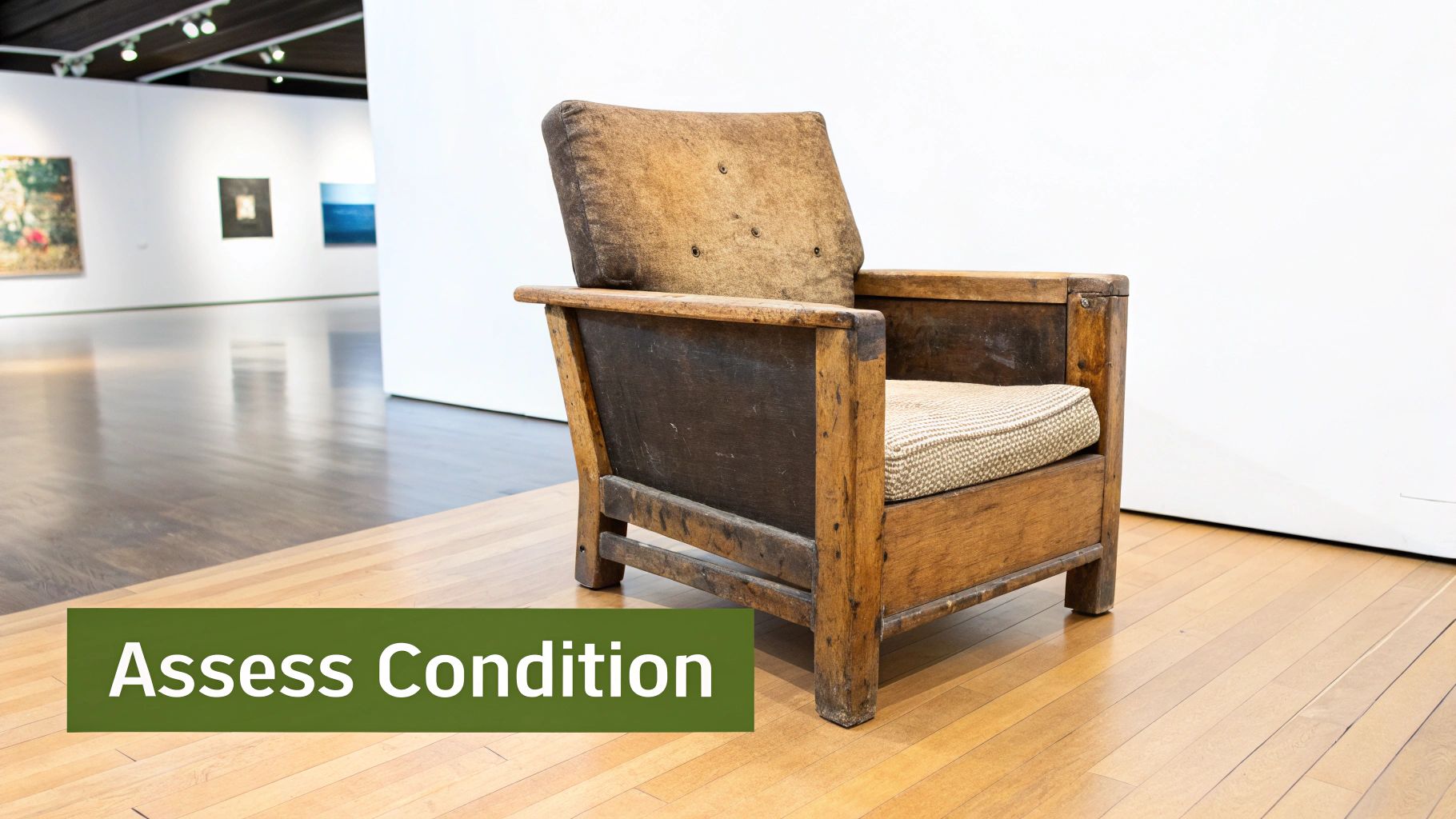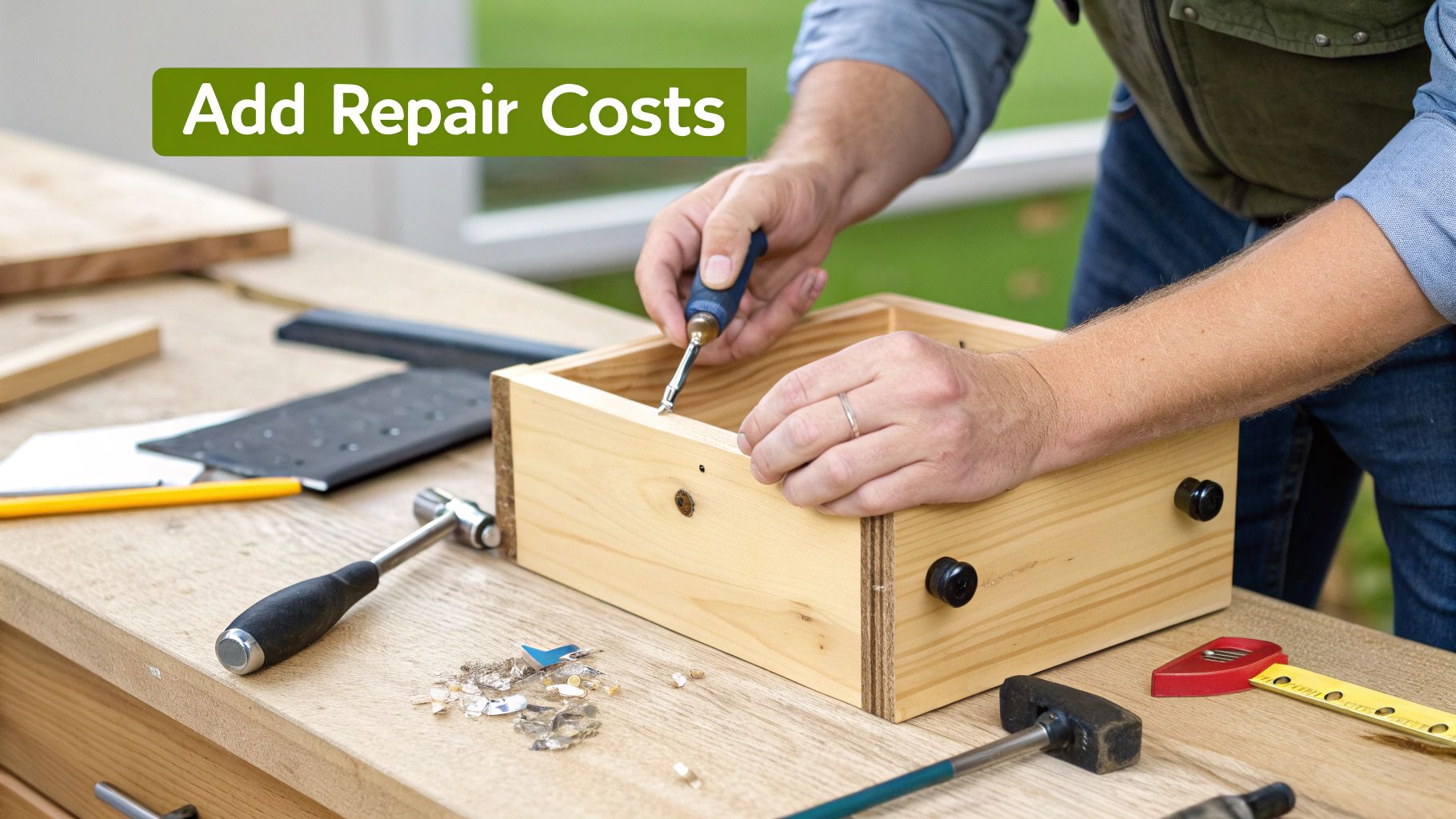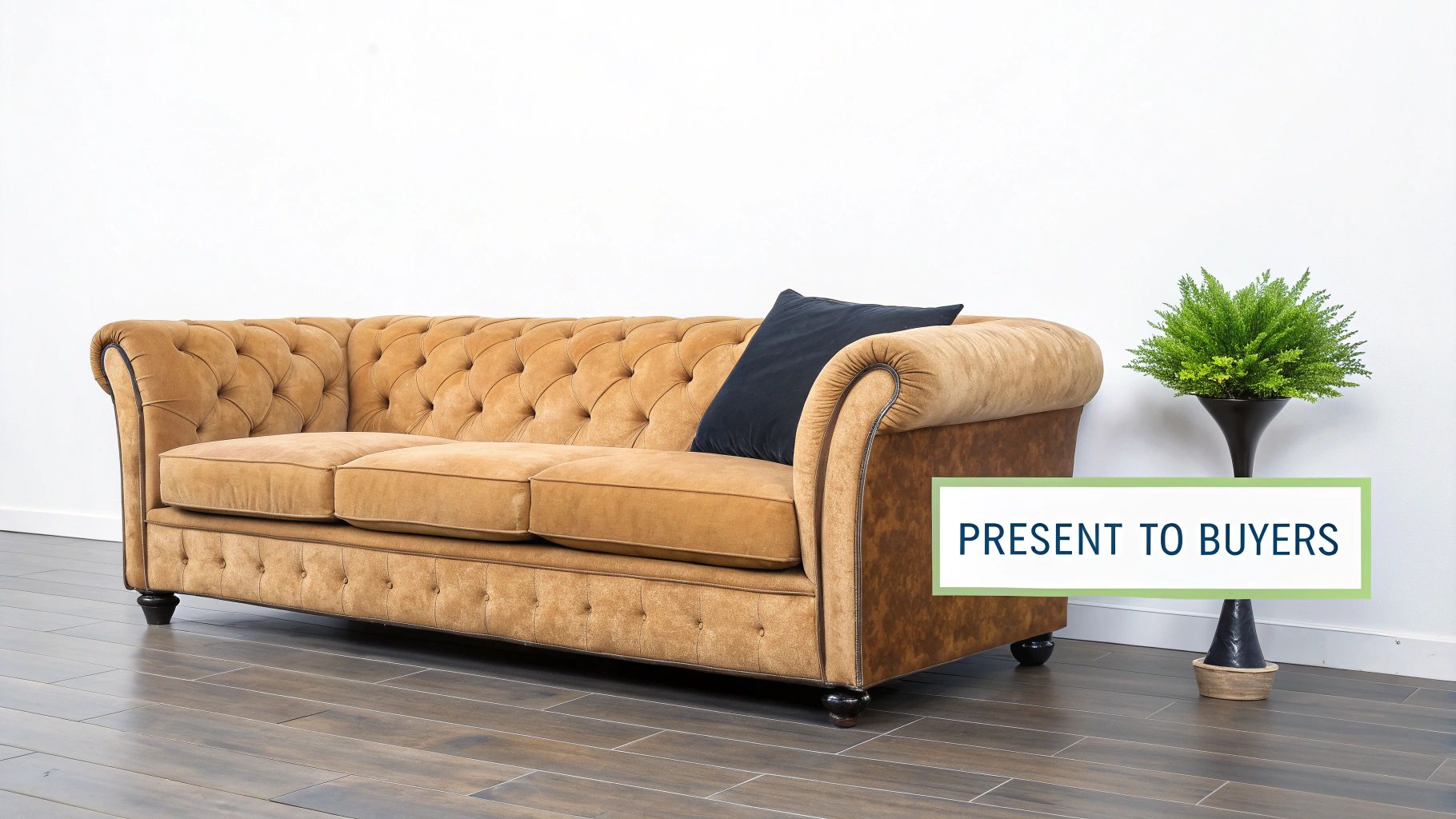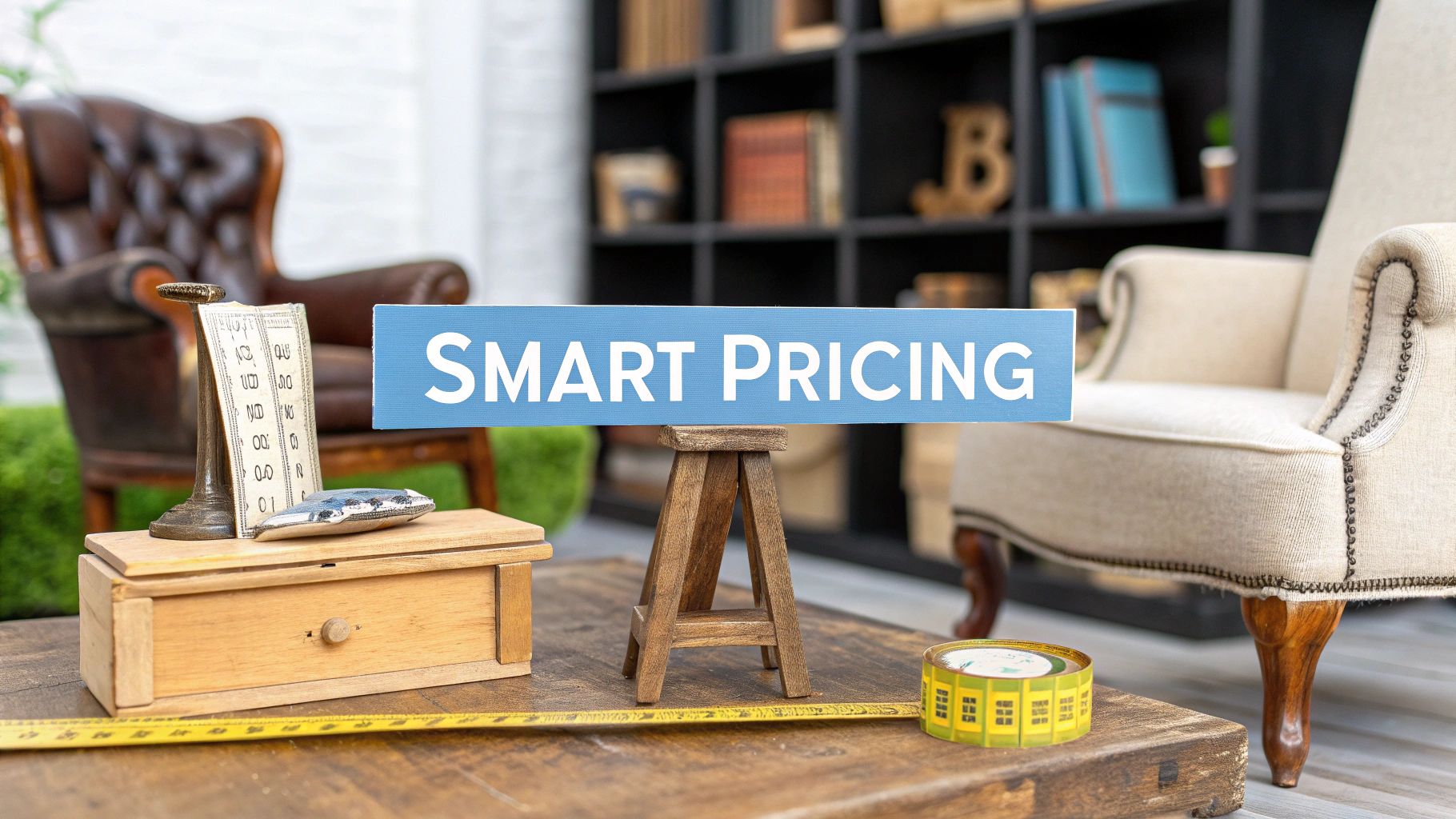Pricing your used furniture is all about finding that sweet spot. You need to balance what you originally paid, its current condition, and what people are actually willing to pay for it right now.
As a solid rule of thumb, a piece in good shape can usually be listed for 50-70% of its original retail price. From that starting point, you can adjust based on things like the brand, its style, and any wear and tear.
Your Quick Guide to Pricing Used Furniture
Figuring out what to ask for your furniture shouldn't be a random guess. It’s more of an art, really—a mix of good research and an honest look at what you’re selling.
Whether you're clearing out clutter, downsizing, or preparing for a residential move, knowing how to value your items is key to a fast, profitable sale. The idea is to land on a price that gets serious buyers interested without you feeling like you gave it away.
Finding Your Starting Point
Before you can think about depreciation, you need a baseline. For most modern furniture, this is easy—it’s what you paid for it. If you're dealing with a vintage or antique piece where the original price is a mystery, you'll need to lean more heavily on market research, which we'll get into.
For now, let’s focus on a simple formula tied to the furniture's condition.
Furniture Pricing At a Glance
Use this quick reference guide to estimate a starting price based on the furniture's original cost and current condition.
| Condition | Description | Suggested Price Range (% of Original Price) |
|---|---|---|
| Like-New | Looks brand new. No scuffs, scratches, or signs of wear. | 80-95% |
| Gently Used | Excellent shape with only minor signs of use, barely noticeable. | 60-80% |
| Good | Structurally solid but has cosmetic flaws like visible scuffs or fading. | 40-60% |
| Project Piece | Needs work. Requires refinishing, repair, or reupholstering. | 10-30% |
Think of these percentages as your starting block. They give you a logical price range before you factor in brand name, current trends, or local demand.
A huge mistake I see people make is letting sentimental value cloud their judgment. We all do it! Try to look at your furniture through a buyer's eyes—be objective, even critical. That impartial view is your best tool for setting a price that actually sells.
Getting to Know Your Furniture Inside and Out
Before you can even think about putting a price tag on a piece of furniture, you have to know exactly what you’re working with—the good, the bad, and the ugly. This isn't just a quick once-over; it's about getting up close and personal with your item. A detailed, honest assessment is the bedrock of a successful sale.

Think of yourself as a furniture detective. The difference between a simple scuff and deep water damage, or solid cherry versus a well-made veneer, can easily swing the value by hundreds of dollars. Trust me, a potential buyer will be looking for these details, so it's far better that you find them first.
Check Out the Bones: Materials and Construction
Let’s start with the fundamentals. What is this thing actually made of? As a general rule, solid wood furniture is going to be worth more than pieces made from particleboard or MDF covered in a thin veneer.
Not sure what you have? There's an easy trick. Look at the edge of a tabletop or the front of a drawer. If you see the wood grain pattern seamlessly wrap around from the top surface to the side, you're likely looking at solid wood. If the edge has a different pattern or looks like a thin, glued-on strip, it's almost certainly veneer.
Once you’ve figured out the material, it’s time to test its sturdiness.
- Do the Wobble Test: Set the piece on a flat surface and give it a gentle push from a few different angles. Does it feel solid, or does it rock and sway? A wobbly leg might be a simple fix, but it's a flaw you absolutely have to disclose.
- Check the Drawers: Pull out every single drawer. Do they glide smoothly, or do they stick and sag? The way drawers function says a lot about the original craftsmanship and how the piece has been treated over the years.
- Inspect the Joints: Take a close look at where the different parts of the furniture connect. You want to see tight, secure joints. Gaps or looseness are red flags.
Keep in mind, there's a world of difference between "honest wear" and "structural damage." A vintage dresser with a few dings has character and tells a story. A modern nightstand with a cracked leg is just broken, and its value will tank.
Spotting the Flaws and Deal-Breakers
Now for the nitty-gritty. It's time to hunt for any issues that could seriously drag down your asking price. Be methodical here and take clear photos of every imperfection you find—you'll need them for your listing later.
Here are some of the most common problems I look for:
- Water Damage: Scan for those tell-tale dark rings, stains, or any bubbling and swelling in the wood. Pay close attention to tabletops and the base of the legs.
- Scratches and Gouges: Learn to tell the difference between minor surface scuffs that are just in the finish and deep gouges that have dug into the wood itself.
- Signs of Pests: Carefully check corners, crevices, and the underside for tiny holes. These can be evidence of woodworms or other unwanted critters.
- Lingering Odors: Don't forget to use your nose! Open up every cabinet and drawer. A strong smell of smoke, pets, or mildew is a major turn-off for most buyers.
Sometimes, a good, proper cleaning can solve minor issues and make a piece look a whole lot more appealing. Just be sure you know what you’re doing, because using the wrong products can cause more harm than good. If you're working with an older item, you can learn more about how to safely clean antique furniture to avoid costly mistakes. Taking these careful steps gives you all the information you need to set a fair price and build a listing that buyers can trust.
Getting to Know the Market to Price Your Furniture Right
Figuring out what your furniture is worth based on its condition is a great start, but it's only half the job. To really nail the price, you have to play detective and see what people are actually paying for similar pieces in your area. This step is what keeps you from pricing a piece so high it gathers dust, or so low you’re practically giving it away.
Your main goal here is to find "comps," which is just shorthand for comparable items. It’s exactly what real estate agents do. They don't just pull a number out of thin air; they look at what similar houses in the same neighborhood sold for. For you, the "neighborhood" is whichever online marketplace you plan to sell on.
Where to Look for Your Comps
The best research happens where the buyers are. You’ll want to focus your time on the platforms where you’re most likely to list your item.
- Facebook Marketplace: This is almost always the best place to begin, especially for local sales. The sheer number of listings gives you a huge amount of data on what’s selling (and what’s not) in your city.
- Specialty Sites like Chairish or AptDeco: If you're selling something high-end, vintage, or from a known designer, these curated sites are a goldmine. The prices you see will be higher, but so will the expectations of the buyers who shop there.
- Local Classifieds (Craigslist, OfferUp): These are fantastic for getting a raw, unfiltered look at what your direct competition is asking. It’s a ground-level view of the market right in your backyard.
Here’s a quick search for a "mid-century modern dresser" on Facebook Marketplace.

You can immediately see the huge price range, even for dressers that look alike at first glance. This is exactly why you need to dig deeper than just a quick scroll.
What to Do With the Info You Find
Don't just glance at the asking prices; you need to look for clues about what actually sells. Pay close attention to how long a listing has been up. If you see a dresser that’s been sitting for two months at $400, that price is probably too steep for your area. On the flip side, if a similar piece was posted three days ago and is already marked "sold," that’s a huge signal you’ve found a sweet spot in the market. You can learn more about all the factors that go into this by understanding what fair market value is.
https://www.curio.app/blog/what-is-fair-market-value
Here’s the key thing to remember: demand is hyper-local. A teak credenza that gets snatched up in a day in a big city might not get a single message for weeks in a rural town. Focus your research on what's happening within a reasonable driving distance for your potential buyers.
This kind of research taps into a bigger picture, too. The global second-hand furniture market was valued at an incredible USD 34.01 billion in 2023 and it's still growing. People are actively looking for sustainable, unique pieces. This just proves there’s healthy demand out there, making your homework even more important.
As a practical example, think about popular brands like IKEA. When you’re pricing a piece, remember that the true cost of assembling IKEA furniture includes time and effort. You can often justify a higher price for an item that's already built and ready to go. By really digging into what’s happening in the current market, you can set a confident price that reflects what local buyers are actually willing to pay.
The Story Behind the Piece: Brand and Style
The story of a piece of furniture—who made it and when—is often just as important as how it looks. A well-known brand or a classic design style can elevate a simple used item into a collector's find, which means you can ask for a higher price.
Frankly, if you ignore these details, you're just leaving money on the table.
Think about it. A generic, no-name bookshelf and one from a respected maker like Ethan Allen might look similar and hold the same number of books, but they're in completely different leagues when it comes to value. For a buyer, that brand name is a promise of quality, craftsmanship, and a certain aesthetic they're willing to pay more for.
Playing Detective: Finding the Maker's Mark
Your first job is to hunt for clues. Most well-made furniture has some kind of maker’s mark, a label, or a stamp that tells you where it came from. This little detail can be the key to unlocking its real worth.
So, where should you look?
- Check the backs of case goods like dressers and cabinets.
- Flip over tables and chairs to inspect the underside.
- Pull out drawers and look inside or on the sides.
You might find a metal plaque, a brand name burned into the wood, or even just a faded paper label. Discovering a name like Herman Miller, Knoll, or a solid, dependable brand like Crate & Barrel gives you a huge advantage. It provides a clear starting point for your research and lets you write a much more compelling listing.
Riding the Wave of Style and Trends
Beyond the brand, the design style itself is a huge factor. Some looks are always in demand, while others are just a passing fad. Figuring out which is which is essential for smart pricing.
Styles like Mid-Century Modern (MCM), with its sleek lines and minimalist feel, have been popular for decades. A vintage MCM credenza can easily be worth more today than a brand-new, mass-produced equivalent. On the other hand, a piece from a short-lived trend might be a tougher sell once its 15 minutes of fame are up.
The real secret is understanding that people aren't just buying an object; they're buying into a specific look or lifestyle. When you're pricing a piece with a strong design identity, you have to know its place in the bigger picture of interior design.
This is all happening within a booming second-hand market. The global market is expected to grow from USD 26.3 billion in 2025 to USD 42.8 billion by 2032. This isn't just about saving money; it's about consumers actively looking for unique, sustainable, and well-made pieces with character.
In fact, one study found that 78% of shoppers in emerging markets would rather buy branded second-hand furniture because they know they're getting lasting value. You can learn more about how consumer preferences shape the second-hand market and see why a good brand name is such a powerful selling point.
Creating a Listing That Justifies Your Price
You’ve done the hard work of assessing your piece and digging into the market data. You've landed on a number that feels right—fair, competitive, and worth your time. But a price is just a number until you prove its value.
This is where the listing comes in. A great listing doesn't just present the furniture; it builds a case for your price and makes a potential buyer feel confident they're getting a great deal. It’s your chance to tell the story and highlight every bit of value you've uncovered.

Think of your listing as the final, crucial step. It’s what separates a quick sale from a piece that sits for weeks.
The Power of Great Photos
On any online marketplace, your photos are your storefront. I can't stress this enough. Dark, blurry, or cluttered photos will torpedo a sale before anyone even reads your description, no matter how amazing the piece is. Good pictures instantly make your furniture look more valuable and make your asking price feel completely reasonable.
You don't need a professional setup. Your smartphone is more than capable. It's all about how you use it.
- Let the Sun In: Natural light is your best friend. Shoot during the day near a window to capture the true color and finish without weird shadows.
- Clear the Stage: Make your furniture the star. Get the laundry basket, the dog toys, and the pile of mail out of the shot. A clean background makes a world of difference.
- Show It All: Give them a full tour. Take photos of the front, back, and sides. Then, zoom in on the details that matter—the beautiful wood grain, the original hardware, or any unique features.
- Don’t Hide the Flaws: This is a big one. If there's a scratch or a chip you're going to mention, take a clear, well-lit photo of it. Showing imperfections upfront builds incredible trust with buyers.
Getting this right is a game-changer. For older pieces where character is key, you can find some fantastic tips on photographing antiques that are useful for any quality furniture.
Writing a Description That Sells
Your words work hand-in-hand with your photos. A strong description is clear, honest, and easy to read, giving buyers all the information they need to say "yes."
First, nail the title. A generic "Brown Dresser" gets lost in the noise. Something like "Solid Wood Mid-Century Modern 6-Drawer Dresser" is packed with keywords that will help the right person find you.
In the body of the description, hit these key points:
- Dimensions: Give the height, width, and depth. This is always one of the first questions, so answer it before they have to ask.
- Materials: Is it solid oak? Walnut veneer? Let them know. Quality materials justify a higher price.
- Brand/Style: If you know the maker or the style (Danish Modern, Art Deco, etc.), put that front and center. Brand names carry weight.
- Condition: Be straight with people. Talk about what’s great ("all drawers slide smoothly") and be transparent about the flaws ("minor scuff on top right corner, see photo").
Your description is where you can add a little personality and tell the story of the piece. Don't just list specs. A sentence like, "This has been a sturdy and reliable dresser for years, perfect for adding a touch of vintage charm to a bedroom," helps a buyer connect with the item and see it in their own home. It makes your price feel not just fair, but deserved.
Getting to the Finish Line: Negotiation and Finalizing Your Sale
Getting an inquiry from an interested buyer is exciting, but it's not the finish line. This is where a little bit of strategy and clear communication can make all the difference, turning a simple "Is this still available?" into cash in your hand.
Handling Offers and Sealing the Deal
Let's be real: you're going to get offers, especially if you're selling on a platform like Facebook Marketplace. It’s just part of the game. Before you even list your item, you need to know your "walk-away" price. What's the absolute lowest you’ll take? Decide this number and stick to it.
Don't be afraid to politely say "No, thank you" to a lowball offer. You've done the work to price your piece fairly, so stand by it. If you're not open to haggling, a simple phrase in your listing like "Price is firm" can save you a lot of back-and-forth. It sets clear expectations from the get-go.
The Logistics: Staying Safe and Getting Paid
Once you and the buyer have settled on a price, it's all about the details. The key here is to be incredibly clear about the logistics to avoid any last-minute confusion.
Who is responsible for moving the furniture? Unless you've agreed to deliver it (and charged for it), make it clear that the buyer is responsible for pickup and transport.
Here’s how to handle the final steps safely:
Getting Paid: For in-person sales, stick to cash or instant payment apps like Venmo or Zelle. Whatever you do, don't hand over the item until you have the payment confirmed. It's best to avoid personal checks or any kind of payment plan.
The Hand-Off: Safety first, always. If the item is small enough, meeting in a busy, public place is ideal. Many local police departments have designated "safe exchange zones" in their parking lots. If the buyer has to come to your home, make sure you're not alone. Have a friend or family member there with you. A great trick is to move the item into your garage or right inside your front door beforehand—this prevents strangers from having to walk all through your house.
Managing this last part of the process well doesn't just protect you; it ensures the buyer has a good experience, too. A smooth, professional transaction is what builds a great reputation for future sales.
Common Questions About Pricing Used Furniture
Even with the best research, a few questions always come up right before you hit "publish" on a listing. Getting clear on these ahead of time will help you price with confidence and make the whole process go a lot smoother. Let's dig into the common hurdles I see sellers face all the time.

The classic dilemma: should you pad the price for hagglers or just set it and forget it? Honestly, there’s no single answer—it really comes down to what you’re selling and how quickly you want it gone.
- Pricing High for Negotiation: I often list unique or high-demand items about 10-15% higher than my bottom-line price. It gives serious buyers a little wiggle room, and they walk away feeling like they got a great deal. This strategy works wonders for quality pieces that you know people are searching for.
- Pricing Firm for a Fast Sale: If you just need something out of your house, don't play games. Price it fairly from the start and add "price is firm" to your description. This little phrase is magic for filtering out lowballers and saving you a ton of back-and-forth messaging.
What If My Furniture Isn't Selling?
So your listing has been up for a week and all you're hearing are crickets. Don't panic, but don't just let it sit there, either. More often than not, the problem is your price or your pictures.
First, try a small price drop. Knocking 10% off can be enough to get it in front of a new set of eyes. If that doesn't work, take new photos. Seriously. Move the item near a window for good natural light and clear away any clutter around it. You'd be amazed what a difference a bright, clean photo makes.
Here's a pro tip for a piece that just won't budge: bundle it. That stubborn nightstand might not be selling on its own, but package it with the matching dresser and suddenly it's a "bedroom set." This boosts the perceived value and helps you clear out multiple items at once.
Finally, people always ask me where they should actually sell their stuff. For everyday furniture, it's hard to beat the massive local audience on Facebook Marketplace. But if you're dealing with high-end, vintage, or designer pieces, a specialized platform like Chairish will connect you with buyers who understand the value and are willing to pay for it.
Feeling stuck with an inherited piece or just want to know more about that cool thrift store find? Let Curio be your expert in your pocket. Just snap a photo, and the app can help identify, date, and value your furniture and antiques instantly. Download Curio today and uncover the stories hiding in your home!
